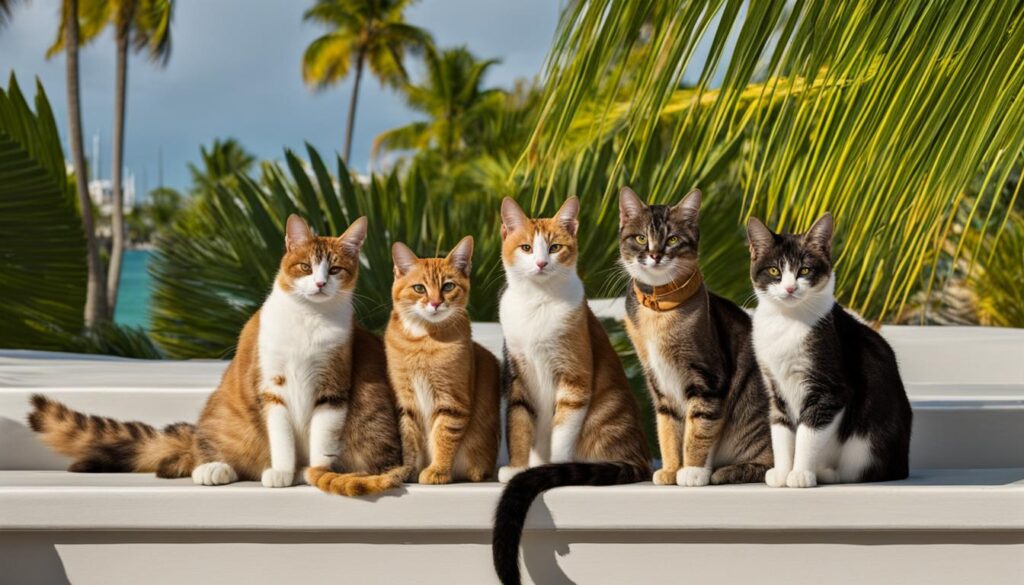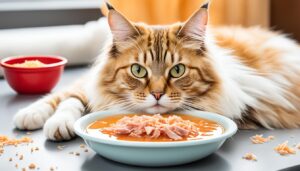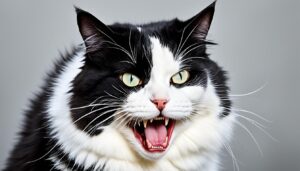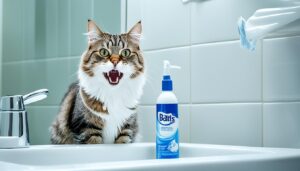Did you know that polydactyl cats, also known as extra-toed cats, have been captivating cat lovers for centuries? With their unique genetic trait of having more toes than the usual number, these remarkable felines possess a rich history and intriguing characteristics that make them truly fascinating.
Key Takeaways:
- Polydactyl cats have more toes on their paws due to a genetic mutation.
- Extra toes are generally not harmful to their health.
- Polydactyl cats are found in various cat breeds and households around the world.
- They have distinct physical characteristics and diverse personalities.
- Regular nail care and grooming are important for their well-being.
What are polydactyl cats?
Polydactyl cats possess an intriguing genetic trait that distinguishes them from their counterparts – they have more toes than the usual number of 18. Unlike regular cats, polydactyl cats can have any number of extra toes, which can appear on any paw. The term “polydactyl” originates from the Greek language and translates to “many toes.” These extraordinary felines, with their unique paw structure, have captivated cat lovers worldwide and have even secured entries in the Book of World Records for their exceptional digit abundance.
Despite their genetic anomaly, polydactyl cats lead normal, fulfilling lives. Let’s delve deeper into what makes these cats so fascinating and discover the various aspects of their alluring traits, history, and care.
The Origins of Polydactyl Cats
Polydactyl cats have a fascinating history that can be traced back to the time of renowned American writer Ernest Hemingway. It is said that Hemingway was gifted a six-toed cat named Snowball, and from there, the legacy of these unique felines began.
Hemingway’s former home in Key West, Florida, now serves as a museum and sanctuary for polydactyl cats, known as “Hemingway cats.” These cats have become a symbol of the writer’s love and appreciation for the unconventional. The Hemingway cats, with their extra toes, have captured the imagination of cat enthusiasts around the world.
The Legacy of Hemingway Cats
The Hemingway cats, also known as Polydactyl cats, not only hold historical significance but also embody the charm and quirkiness that make them so beloved. They continue to thrive and multiply at the Hemingway Home and Museum, where visitors can observe and interact with these remarkable felines.
Today, polydactyl cats are not limited to one specific breed. They can be found in various cat breeds and households worldwide, charming their way into the hearts of their owners and showcasing their unique genetic trait.
Polydactyl Cats in Different Breeds
While polydactyly can occur in any cat breed, certain breeds have a higher incidence of polydactyl individuals. Here is a comparison of some cat breeds known for their polydactyl cats:
| Breed | Origin | Characteristics |
|---|---|---|
| Maine Coon | United States | Larger size, sturdy build, gentle and friendly nature |
| American Shorthair | United States | Medium to large size, muscular build, adaptable and sociable |
These breeds, among others, have been known to produce polydactyl cats. The inheritance of polydactyly adds an element of surprise and wonder to each new litter, making these cats even more intriguing and desirable.
Physical Characteristics of Polydactyl Cats
Polydactyl cats possess unique physical traits that set them apart from other feline companions. The most prominent feature of these cats is their extra toes, which can range in number from a few additional digits to as many as eight on each paw. These extra toes contribute to a distinct appearance, giving their paws a larger and more rounded shape, reminiscent of adorable mittens.
Just like any other cat, polydactyl cats can vary in size, body shape, coat color, and eye color. Their overall physical appearance is not exclusively determined by their extra toes, but rather a combination of genetic factors that make each polydactyl cat an individual with a unique look and personality.
Distinctive Physical Traits of Polydactyl Cats
- Extra toes on the paws, resembling mittens
- Paws with a larger and more rounded appearance
- Variation in the number of extra toes
- Different sizes and body shapes
- Wide range of coat colors and eye colors
These physical characteristics make polydactyl cats truly unique and captivating. Their extra toes add an element of charm to their overall appearance, making them stand out in a crowd.
Polydactyl Cats: Personality and Temperament
Polydactyl cats exhibit a remarkable spectrum of personalities and temperaments, with each individual showcasing their unique character traits. While there are no specific personality traits directly linked to polydactyly, these felines are known for their friendly nature, sociability, and intelligence.
Sociable: Polydactyl cats have an innate affinity for human companionship. They enjoy the company of their owners and are often found seeking attention and engaging in playful interactions. Their sociable nature makes them wonderful companions and beloved family pets.
Intelligent: Polydactyl cats demonstrate exceptional intelligence. They possess a keen ability to adapt to new environments and solve problems. This intelligence, coupled with their playful nature, makes them highly trainable and responsive to interactive toys and puzzles.
Independence: While being sociable and affectionate, polydactyl cats also appreciate their own space. They have a healthy sense of independence and may occasionally retreat to quiet corners or high perches to enjoy some alone time and observe their surroundings.
Overall, the unique personality and temperament of polydactyl cats make them delightful companions, combining a sociable nature, intelligence, and an independent spirit.
| Polydactyl Cat Personality Traits | Description |
|---|---|
| Friendly | Polydactyl cats are known for their friendly and approachable nature, making them well-suited for households with children and other pets. |
| Sociable | These felines thrive on human interaction and enjoy being part of family activities. They often seek attention and are social butterflies. |
| Intelligent | Polydactyl cats display a high level of intelligence, which helps them adapt to new situations quickly and learn new tricks and behaviors. |
| Playful | With their playful nature, polydactyl cats excel at interactive play sessions and can entertain themselves for hours with toys and puzzles. |
| Independent | Despite their sociability, polydactyl cats appreciate their alone time and value having their personal space. |
Caring for Polydactyl Cats
When it comes to polydactyl cat care, the basics remain the same as caring for any other cat. However, due to their extra toes, certain aspects require additional attention and care. Nail care is an essential part of grooming polydactyl cats, as the nails can grow excessively and become prone to ingrown issues if not properly maintained. Regular trimming is necessary to keep their nails at an appropriate length.
Grooming is another crucial aspect of polydactyl cat care. Brushing their fur regularly helps to remove loose hair, prevent matting, and keep their coat healthy and shiny. It is also important to pay special attention to their paws. Check their extra toes for any signs of redness, swelling, or discomfort. Cleaning between the toes and monitoring for any abnormalities is essential for their overall well-being.
Providing a balanced diet is paramount to maintaining the health of polydactyl cats. Consult with your veterinarian to determine the appropriate type and amount of food to feed your cat based on their age, weight, and specific dietary needs. Proper nutrition plays a vital role in supporting their overall health, including the condition of their coat, skin, and nails.
In addition to physical care, polydactyl cats also benefit from engaging in interactive play sessions. Exercise not only keeps them physically active and mentally stimulated but also helps to prevent obesity and related health issues. Interactive toys and playtime create a bond with your cat, enhancing their overall well-being and happiness.
Regular veterinary check-ups are a crucial part of caring for polydactyl cats. These visits allow professionals to monitor your cat’s health, address any concerns, and ensure they are up to date on vaccinations and preventive treatments. Regular examinations help detect any potential health issues early on, providing the best chance for successful treatment and a long, healthy life for your feline friend.
| Essential Care Tips for Polydactyl Cats |
|---|
| 1. Nail Care: Regularly trim their nails to prevent overgrowth and potential nail issues. |
| 2. Grooming: Brush their fur regularly and pay special attention to their extra toes and paws. |
| 3. Balanced Diet: Consult with your veterinarian to ensure they are receiving proper nutrition. |
| 4. Interactive Play: Engage in interactive play sessions to keep them mentally and physically active. |
| 5. Regular Vet Check-ups: Schedule routine veterinary visits to monitor their health and address any concerns. |
Famous Polydactyl Cats

One of the most famous groups of polydactyl cats is the Hemingway cats that reside in the Ernest Hemingway Home and Museum in Key West, Florida. These cats are descendants of a six-toed cat named Snowball, who was gifted to writer Ernest Hemingway. The Hemingway cats have become iconic and are a major attraction for visitors to the museum.
The Hemingway Cats at the Ernest Hemingway Home and Museum
The Hemingway cats, also known as polydactyl cats, have a long history that dates back to Ernest Hemingway’s time. These cats are named after the famous writer who had a deep affection for polydactyl felines. It is said that Hemingway was gifted Snowball, a six-toed cat, and from there, the legacy of these extraordinary cats began.
The Ernest Hemingway Home and Museum in Key West, Florida, is home to approximately 40-50 polydactyl cats who are direct descendants of Snowball. These cats roam freely on the premises of the museum, delighting visitors with their unique paws and charming personalities.
| Name | Color | Number of Toes |
|---|---|---|
| Snowball | White | 6 |
| Papa | Gray | 7 |
| Martha | Calico | 8 |
| Ernestine | Tabby | 6 |
These Hemingway cats have become celebrities in their own right, with their unique appearance and connection to the legendary writer. Visitors from around the world flock to the Ernest Hemingway Home and Museum to catch a glimpse of these fascinating polydactyl cats.
Health Issues of Polydactyl Cats
Polydactyl cats, with their extra toes, do not have any specific health issues directly related to their unique trait. However, their nail care requires special attention to prevent discomfort or injury.
Due to the additional toes, polydactyl cats’ nails can grow excessively and easily become ingrown if not properly maintained. Regular nail trimming is essential to ensure their claws remain at a comfortable length.
Poor nail care can result in various issues for polydactyl cats, such as:
- Ingrown nails: If the nails grow too long, they can curve and grow into the paw pad, leading to pain, infection, and difficulty walking.
- Nail breakage: Longer nails are more prone to breakage, which can be painful and may lead to bleeding or infections.
- Scratching damage: Overgrown nails can cause damage to furniture, carpets, and other surfaces and can even accidentally injure their owners or other pets during play.
Regular nail care for polydactyl cats involves gently trimming their nails to an appropriate length. It is recommended to use cat-specific nail clippers and to be cautious to avoid cutting into the quick, which can cause bleeding and pain.
Additionally, it is important to check for any signs of complications related to the extra toes when maintaining their nail care. Look for nail overgrowth, ingrown nails, or any signs of redness, swelling, or pain in the nail area.
Polydactyl Cats in Different Breeds

While polydactyly can occur in any cat breed, certain breeds are more commonly associated with having polydactyl individuals. The Maine Coon and American Shorthair breeds often have a higher incidence of polydactyly. However, polydactyl cats can also be found in domestic shorthairs and other breeds. The inheritance of polydactyly adds an element of surprise and wonder to each new litter.
Some of the popular breed variations of polydactyl cats include:
| Breed | Description |
|---|---|
| Maine Coon | The Maine Coon, a beloved breed known for its large size and friendly nature, often produces polydactyl kittens. These extra-toed beauties add to the charm and uniqueness of the already stunning Maine Coon breed. |
| American Shorthair | American Shorthair cats, known for their versatility and adaptability, also have a higher likelihood of polydactyly. This addition of extra toes further showcases the diversity of this breed. |
| Domestic Shorthair and Other Breeds | In addition to the Maine Coon and American Shorthair breeds, polydactyl cats can also be found in domestic shorthairs and other cat breeds. The occurrence of polydactyly in these breeds adds an intriguing factor to their lineage. |
Regardless of the breed, each polydactyl cat is a unique and special individual, adding an element of fascination and curiosity to the feline world.
Myth Debunked: Balance and Agility of Polydactyl Cats
Contrary to popular belief, having extra toes does not affect a cat’s balance or agility. In fact, the additional toes provide polydactyl cats with enhanced stability and dexterity, allowing them to navigate their surroundings with ease. Their unique paw structure does not hinder their physical abilities and does not pose any disadvantage or challenge to their balance or agility.
The myth about polydactyl cats lacking balance and agility is unfounded. These cats have an innate ability to adapt and excel in various physical activities, just like any other feline. Their extra toes provide them with a solid foundation and a wider surface area to support their movements.
Some people mistakenly assume that polydactyl cats may struggle with coordination or experience difficulties in climbing or jumping. However, this perception is baseless. Polydactyl cats exhibit grace and athleticism in their movements, effortlessly showcasing their agility in various playtime activities.
Studies have shown that polydactyl cats possess excellent coordination skills, allowing them to maintain their balance even in challenging situations. The additional toes contribute to their overall stability, providing them with an advantage when climbing trees, exploring heights, or engaging in acrobatic maneuvers.
To debunk this myth further, let’s compare the balance and agility of polydactyl cats to that of cats with the typical number of toes. Here’s a table that highlights the similarities:
| Aspect | Polydactyl Cats | Cats with Typical Toes |
|---|---|---|
| Balance | Polydactyl cats have a natural sense of balance, aided by their extra toes. | Cats with typical toes also possess excellent balance skills. |
| Agility | Polydactyl cats are agile and nimble, capable of performing intricate movements. | Cats with typical toes exhibit remarkable agility in their actions. |
| Jumping Ability | Polydactyl cats can jump with impressive precision and accuracy. | Cats with typical toes also demonstrate exceptional jumping abilities. |
As illustrated in the table, polydactyl cats possess the same balance, agility, and jumping ability as cats with the normal number of toes. Their unique genetic trait does not hinder their physical capabilities in any way.
In conclusion, the myth suggesting that polydactyl cats lack balance and agility is untrue. These extraordinary felines embrace their additional toes, utilizing them to their advantage. Polydactyl cats are just as agile, graceful, and capable as any other cat, debunking the misconception surrounding their physical abilities.
Life Expectancy of Polydactyl Cats
Polydactyl cats, like their non-polydactyl counterparts, typically have a life expectancy of around 13 to 17 years. However, several factors can influence their longevity and overall well-being.
Genetics play a significant role in a cat’s lifespan, regardless of whether they have extra toes or not. Certain genetic predispositions or inherited conditions may impact their health and longevity. Regular veterinary check-ups can help identify and manage any potential health issues, ensuring the best possible care for your polydactyl cat.
Diet and exercise are also crucial factors in maintaining a polydactyl cat’s health and extending their lifespan. A balanced diet tailored to their specific nutritional needs, along with regular exercise, can help prevent obesity and promote overall well-being.
Factors Influencing the Life Expectancy of Polydactyl Cats
| Factors | Impact on Life Expectancy |
|---|---|
| Genetics | Can determine inherited conditions and overall health |
| Diet | Proper nutrition supports overall well-being |
| Exercise | Regular physical activity helps prevent obesity and promotes health |
| Veterinary Care | Regular check-ups ensure early detection and management of health issues |
By prioritizing these aspects and providing a nurturing and stimulating environment, polydactyl cat owners can help optimize their furry friends’ lifespan and ensure they live a happy and healthy life.
Conclusion
In conclusion, polydactyl cats are truly fascinating creatures with their unique extra toes. They have a rich history, dating back to the time of renowned American writer Ernest Hemingway and his beloved six-toed cat Snowball. Today, polydactyl cats can be found in various cat breeds and households around the world, captivating cat lovers with their distinctive physical characteristics and charming personalities.
Caring for polydactyl cats involves regular nail care and grooming, as their extra toes require special attention. However, despite their unique paw structure, polydactyl cats have no issues with balance or agility. In fact, their extra toes provide them with enhanced stability and dexterity, allowing them to navigate their surroundings with ease.
With proper care and attention, polydactyl cats can live fulfilling lives and bring joy to their owners. Their sociable nature, intelligence, and playful personalities make them wonderful companions. So, if you’re considering adding a furry friend to your family, why not consider a polydactyl cat? They are sure to enchant you with their extra toes and endearing quirks.
FAQ
What are polydactyl cats?
What are the origins of polydactyl cats?
What are the physical characteristics of polydactyl cats?
What is the personality and temperament of polydactyl cats?
How do I care for polydactyl cats?
Are there any famous polydactyl cats?
Do polydactyl cats have any health issues?
Which cat breeds are commonly associated with polydactyl cats?
Is it true that polydactyl cats have balance and agility issues?
What is the life expectancy of polydactyl cats?
How common are polydactyl cats?
What causes polydactylism in cats?
Can polydactyl cats be registered with cat registries?
Are there different types of polydactyl cats?
Are polydactyl cats more expensive to purchase?
Can polydactyl cats be trained to do tricks?
Are polydactyl cats more agile than non-polydactyl cats?
Do polydactyl cats have any special dietary requirements?
Can polydactyl cats be adopted from shelters?
Are polydactyl cats more prone to scratching furniture?
Can polydactyl cats be declawed?
Do polydactyl cats have any unique personality traits?
Are polydactyl cats more affectionate than non-polydactyl cats?
Can polydactyl cats be bred selectively?
Do polydactyl cats have any special grooming requirements?
Are polydactyl cats more prone to getting their toes caught in things?
Can polydactyl cats be trained to use a litter box?
Do polydactyl cats have any special housing requirements?
Are polydactyl cats more prone to developing arthritis?
Can polydactyl cats be used for specific purposes, such as hunting or pest control?
Are polydactyl cats more popular in certain regions or cultures?
Can polydactyl cats be registered with breed-specific registries?
Do polydactyl cats have any unique physical characteristics beyond their extra toes?
Can polydactyl cats be found in other species of felines, or is it exclusive to domestic cats?
Are there any historical or cultural associations with polydactyl cats?
Can polydactyl cats be used in breeding programs to produce more polydactyl offspring?
Are there any specific health concerns or considerations for older polydactyl cats?
References
| International Cat Association (TICA) | https://www.tica.org/ |
| The Cat Fanciers’ Association (CFA) | https://cfa.org/ |
| World Cat Federation (WCF) | https://www.wcf-online.de/ |
| Fédération Internationale Féline (FIFe) | https://www.fifeweb.org/ |








[…] Collies have a fascinating history that can be traced back to their Scottish roots. These charming dogs were originally bred for […]
[…] present, the Anatolian Shepherd’s intelligence and power have been celebrated. Let’s explore the rich history, defining physical characteristics, unique temperament, and important considerations for caring for […]
[…] has a fascinating history rooted in the southern United States, potentially descending from dogs brought by Spanish […]
[…] just their good looks. Persian Cats have a distinctive personality and temperament, making them a fascinating study for anyone interested in feline behavior and psychology. In this guide, we will explore all aspects of the Persian Cat, so you can […]
[…] Cats might find tulips fascinating, but owners should make sure they can’t get to them. This will help keep cats safe. […]
[…] a blood glucose level check. A lower-than-normal blood glucose level, in combination with the cat’s history and clinical signs, can confirm the diagnosis. To determine the underlying cause of the […]